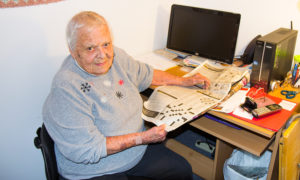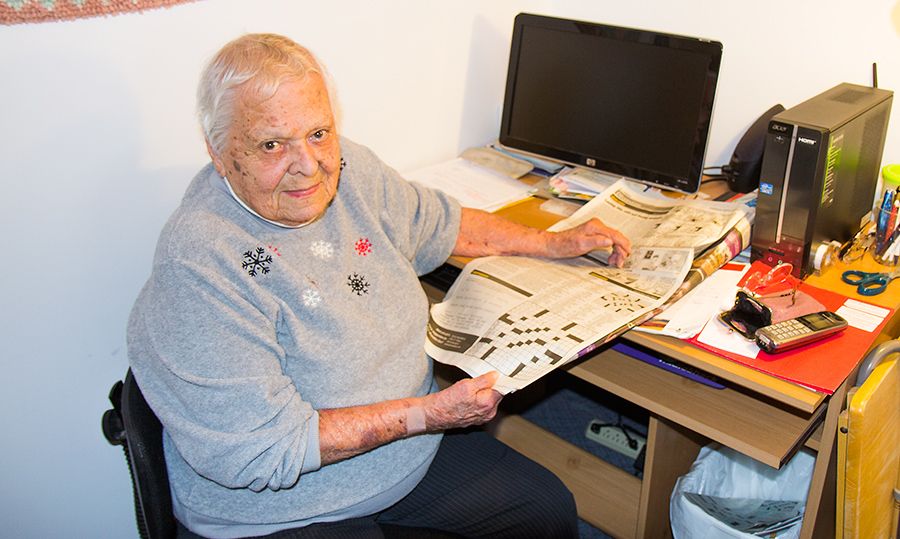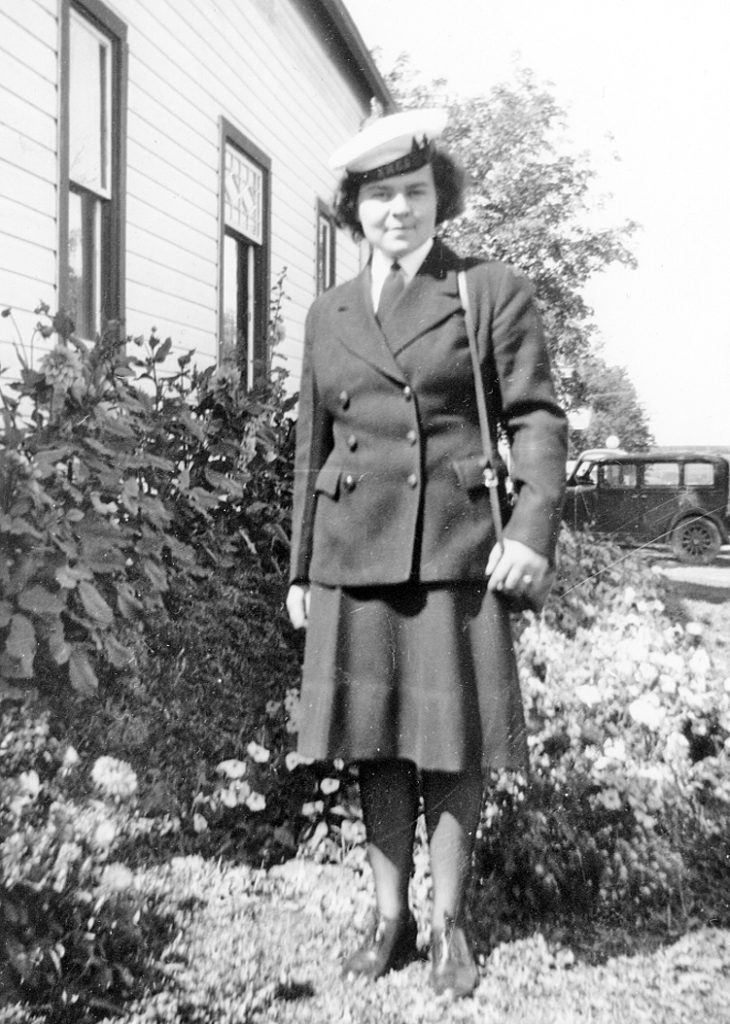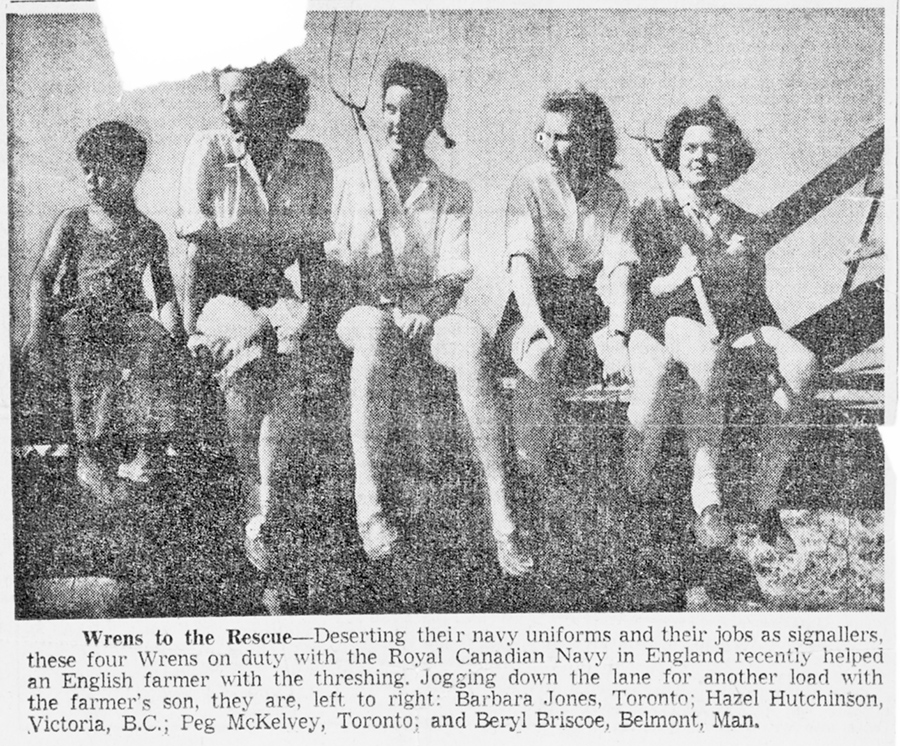
Beryl Vigneux left high school to join the Canadian Navy – and seek adventure
BY KIM LANGEN
Growing up during the Depression, in a small Prairie town, two schoolgirls harboured the dream of escaping from the ordinary.
Ten years of the terrible Depression had finally ended, with the beginning of World War II in 1939, and life was beginning to open up again, with new opportunities.
“I had a friend, and we chatted about going into the services on the way to school, all four blocks,” said Beryl Vigneux, nee Briscoe. “Her name was Laura Lang, and we were both in Grade 11, in the same class. I was born and raised in Belmont, and my dad and uncle had the garage there, Briscoe Brothers Garage. It was an up and coming town back then. But there were no jobs for young people.”
A decade of the Great Depression lasted from 1929 until 1939. Beryl, born in 1924, said she could recall how much the family struggled to manage.
“When I was in school, during the Depression, my mother once told me there was just 25 cents left in the pot. And that was going into the church collection plate on Sunday,” she said. “My father was ill. To make some income, my mom served meals from our house, and she rented out a room. She always made it clear to us that we didn’t have money to throw around. It was very hard on her.”
So when the two girls turned 18, they set their sights on adventure, far away from their small town and families.
“I can’t remember what triggered us to choose the Navy – it’s too many years ago now – but that’s what we decided,” said Beryl. “You had to be 18 in order to enlist and that’s what we did. I didn’t take Grade 12, period. I would rather join the Navy. I thought it was a way out. I had been working as a relief switchboard operator for the Municipality of Belmont, while I was in school. What else was there for us to do? The only option was to stay in Belmont, and be a telephone operator.”
The two young women enlisted, and in the winter of 1942/43 they prepared themselves to step onto the train bound for Winnipeg to begin their new lives.
But fate intervened, slowing their fast exit from the Prairies.
“There was a huge snowstorm, and it stopped the trains for two weeks,” said Beryl. “So we had to think about it. But we didn’t change our minds. We both wanted something different and exciting, and we thought we would find it in the Navy. We got on the train in Belmont, and went to Winnipeg.”
From Winnipeg, the pair went on to Galt, Ontario, for their Basic Training.
“There was a lot of marching,” said Beryl. “And a lot of exercise. It was pretty lonesome, leaving your family, my mom and dad, and my two brothers and three sisters. I was the second youngest.”
Following basic training, Beryl was sent east to Signal School for more naval education.
“Then I was moved to Quebec, to Signal School. I had chosen wireless telegraphy, and I learned Morse Code in Saint Hyacinthe,” she said. “Laura went west, maybe to Vancouver, and I went east. I don’t know where she went; we lost touch.”
St. Hyacinthe was the Royal Canadian Navy’s Communications School during the Second World War, and was situated 35 miles east of Montreal.
At its peak, the student population reached about 2,600, and during nearly five years of service, St. Hyacinthe trained 9,600 sailors, Wrens (WRCNS), and Signal Officers in the many skills of naval communications. It was considered to be the biggest signals school in the British Empire.
The course load was heavy for both staff and students. The skills of Semaphore, Flashing Light, Morse Telegraphy, and Typing were instilled into prairie farmers, factory workers, fishermen, and any other young men determined to go to sea.
“Coders” learned the secret ciphers and techniques needed in wartime communications, while ‘Radio Artificers’ learned the mysteries of vacuum theory, and taught the skills for maintaining their own transmitters and receivers.
Wrens, like Beryl, were given specialist courses to enable them to carry out the duties of Signal Officers at shore bases. They were also trained as radio and signal operators for shore duty, freeing up the men who were needed at sea.
“We slept in barracks, and wore our uniforms – a skirt and jacket, navy blue, with black Lisle stockings, and black Oxford shoes,” said Beryl. “And we wore bloomers, with elastic around the knees, so that when we climbed the ladders the sailors couldn’t look up our skirts. They had a bank of radios for us, to receive the code. There must have been around 40 of them. With practise, you learn it (Morse Code). I still remember most of it. It’s a series of dots and dashes that represent each letter of the alphabet, and for numbers. We learned to copy the Morse Code messages.”
After completing the 160-day W/T (Special Operator Course), Beryl was assigned to her post.
“After I graduated I was sent to Edwards, Ontario, where I was stationed,” said Beryl. “It was a tiny little town outside of Ottawa. The station held around 80 women. We lived in barracks, maybe six of us to a room, in bunk beds. There was a big mess hall for us to eat our meals. I learned to play bridge, and we played a lot of bridge. But I always thought about my mom. My father was in a nursing home, and she had a lot of responsibility at home with the children.”
Meanwhile, there was a job to be done with the Navy. German U-boats (submarines) were wreaking havoc on the seas, and Beryl’s job, along with the other Wrens, was to intercept the messages being sent in Morse code.
“We would copy the code, onto sheets, and it was sent away to be deciphered,” she said. “If a U-boat sent a message to Germany, we would copy it. We would also take a bearing on it, to find out where the U-boat was located. There were rows of women taking messages, and once in a while there was a break in the message. It meant that a U-boat had come up from the water, and had received a message, and they had related that message to headquarters. Sometimes it was a message about what they saw on our shores. The U-boats usually cruised around Halifax, and along the West Coast. It was sent to Ottawa for deciphering. It wasn’t our job to decipher the messages – we just copied the code, and sent it on.”
In June of 1942, German submarines had been sinking an Allied ship every four hours, according to Manitoba’s Naval Museum History.
And for every U-boat being sunk, five more were being built. The Canadian Navy needed their manpower for sea duty, so women between the ages of 18 and 45 – like Beryl – were being recruited for duty.
Training for the Wrens in Canada, which was based and trained on the English model, had begun in 1942, and it was decommissioned at the end of the Second World War.
By the end of August 1945, some 6,783 women had enlisted in the WRCNS. None of them were killed in action, but 11 died while on duty, due to illness or accidents.
For Beryl Briscoe, the years she spent working during World War II were an important and memorable part of her young life.
Concerns about her home and family were frequently on her mind, but she also loved being part of the action, and of a team of women doing an important job.
“I think I learned something,” she said. “I’d like to say I helped with the war effort. Somebody had to copy the code. It was quite something when you heard the message from the Germans. It would give you shivers up your spine. You would hope you got the message right. I was proud to do the job. It was something that Laura and I had discussed for a long time. I wish I knew what happened to her. And I always worried about my mother, and wondered if I should have stayed home to help her.”
Beryl later married Navy tool-and-die maker Lawrence Vigneux, who she met at a dance at the Edwards base. They were married just after the war, on September 3, 1945, in Belmont.
What happened to the Canadian Wrens?
War in Europe (V-E Day) ended on May 8, 1945, and Japan surrendered on August 15, 1945 (V-J Day).
Demobilization of the Wrens began immediately after V-J Day, and by August 31, 1945, they no longer existed.
A Women’s Reserve in the Royal Canadian Naval Reserve (RCNR) was later established in 1951, and approximately 700 Wrens joined.
In January of 1955 Cabinet approved a nucleus of regular force Wrens for the Royal Canadian Navy.
And a month later the Ministry of National Defense made history, as the Wrens became totally integrated into the regular force of the Royal Canadian Navy.
Today all three forces come under one heading – The Canadian Armed Forces – and the Wren women are now known as Service Women.

WORLD WAR II WREN TELEGRAPHIST – Beryl Vigneux (nee Briscoe), 95, joined the Navy in 1943, after finishing her Grade 11 in Belmont. She was just 18 when she enlisted, along with her best friend, and Beryl later became a WRCNS (Women’s Royal Canadian Naval Service) Telegrapher, and was trained to make copies of the enemy’s secret Morse Code messages. Above, today at her home at Killarney’s Lakeview Villa, she still does the crossword, uses the Internet, and gets around town in her car.

BELMONT WREN – Beryl Briscoe, at age 18 or 19, who served as a Wren telegraphist with the Royal Canadian Navy from around 1943 to 1945. Beryl, a lifetime member of the Canadian Legion, left her home in Belmont after Grade 11 to join the navy, and learned to copy Morse code, sent from roving German U-boats and intercepted by the Canadians.


